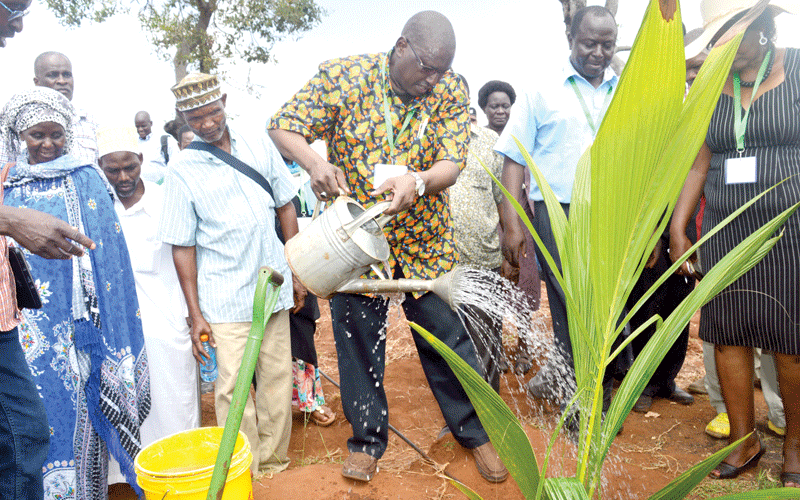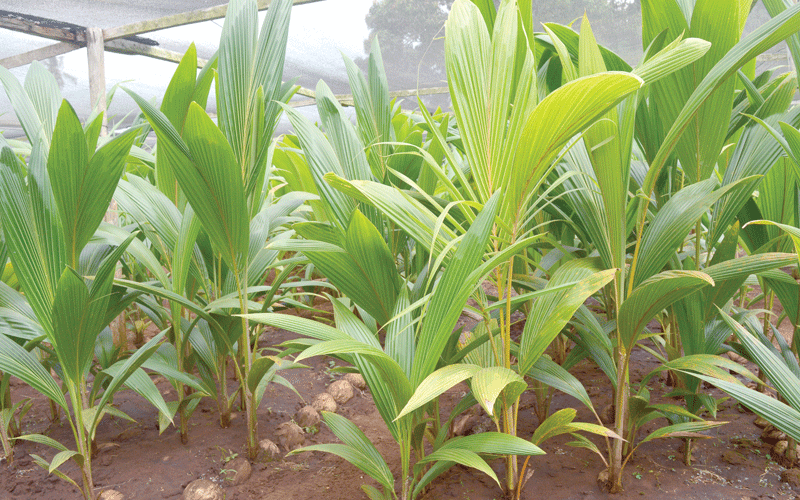New coconut variety to boost Coast production
By Wahinya Henry, September 23, 2019
Fortunes of farmers at the Coast are set to change after a new, higher yielding coconut variety was launched in Kwale county.
Coast residents went viral on sicial media soon after the launch of the project by the Director General of Kenya Agricultural and Livestock Research Organisation (Kalro), Dr Eliud Kireger at the organisations’ centre in Matuga, Kwale county in February this year.
The new strain is a cross between the commercial tall coconut and the dwarf variies.
It takes three years to mature and produces 250-300 nuts annually as opposed to the tall variety, which takes five to seven years to produce an average of 100 nuts per year.
Pole Shinyange, a researcher at the centre says seedlings that were transplanted to a 20-acre farm are doing well.
“The only challenge is a pest, the rhinocerous beetle, which has been attacking some of the plants but we have acquired traps from South Africa to contain it,” he adds.
Some farmers who have bought seedlings from us at Sh500 are also complaining of water shortages in dry seasons,” he says.

Photo/PD/ WAHINYA HENRY
Often hailed, as a ‘sleeping giant’, the coconut sub- sector is a lifeline of the coastal counties of Mombasa, Kilifi, Kwale, Tana River, Taita Taveta and Lamu.
Improving the crop’s value chain is expected to boost earnings from the current annual income of Sh12 billion to Sh25 billion. The crop contributes an estimated 1.5 per cent to the agricultural production and 0.4 per cent to Kenya’s GDP.
More than 120 products are sourced from coconut, supporting families in nutrition, housing and health.
An estimated 100,000 farmers depend on the crop for survival. In 2017, Kenya produced 124,000 tonnes of coconut, the 2018 Economic Survey says.
The collapse of cooperative societies in early 1980s denied farmers bargaining power and opportunity to exploit potential markets.
Farmers say during the high tourism season (July/September and December/January) they sell nuts at Sh5 from Sh3 each.
India imports
Kenya produces 240 million nuts annually from 9.9 million coconut trees. In contrast, India produces 17 billion nuts annually from its 300 million trees.Some 5,000 seed nuts were brought in from India in December 2018 and preserved in a quarantine site under Kephis supervision at Karlo Matuga Centre.
Kireger says the research project will contribute tremendously to the local economy as a result of advanced farming.

He said the hybrid nuts imported from India at Sh3,000 per seedling were different from local palms as they mature faster and yielded bigger harvests.
Ministry of Agriculture and Livestock PS Prof Hamadi Boga through her representative Jane Otado has appealed to the county governments to work with Karlo to ensure success of the pilot project.
“There is also need for the State to build factories to manufacture coconut products instead of importing them,” said Otado.
“The hybrid palms are also product-specific for the coconut’s water, oil content, fibre content, or palm wine production, while the indigenous crop is planted by chance,” Agriculture expert, Baha Nguma, said.
The establishment of Kenya Coconut Development Authority (KCDA) in July 2008 and government’s move to classify the coconut tree as a “special crop” gave the nut the same status as coffee and tea.
KCDA has since been transformed to Nuts and Oil Crops Directorate (NOCD) under the agricultural regulator, Agriculture, Fisheries and Food Authority (Affa).
The Ministry of Trade estimates that Kenya could save more than Sh8 billion annually on imports if it increases oil production from coconuts.
The country imports approximately 400,000 metric tonnes of oil annually worth Sh14 billion, of which 120,000 metric tonnes (30 per cent) is used in soap making.
Currently, the crop’s main product is wine, which constitutes 60 per cent, nuts, 24 per cent, fronds (for roofing) 12 per cent while brooms and coco wood constitute 24 and 0.3 per cent respectively.
“When you produce one product, its by-products becomes raw materials for another chain,” says Raymond Kahindi of NOCD.
For instance the shell of a nut (husk), which is usually wasted, can be processed into coco dust for use in horticulture as a growing medium. It also produces activated carbon charcoal, used as a fuel alternative.
Similarly, the coconut meat produces edible oils and desiccated nuts. The fibre, usually wasted, can be processed into house material products or in making nets for use in greenhouses.
Only two major producers export coconut and virgin oil to foreign markets.
Currently the country imports value added coconut products estimated at Sh800 million annually. Researcher Gachanja Githende, says prior to the establishment of KCDA, many farmers had abandoned the crop.